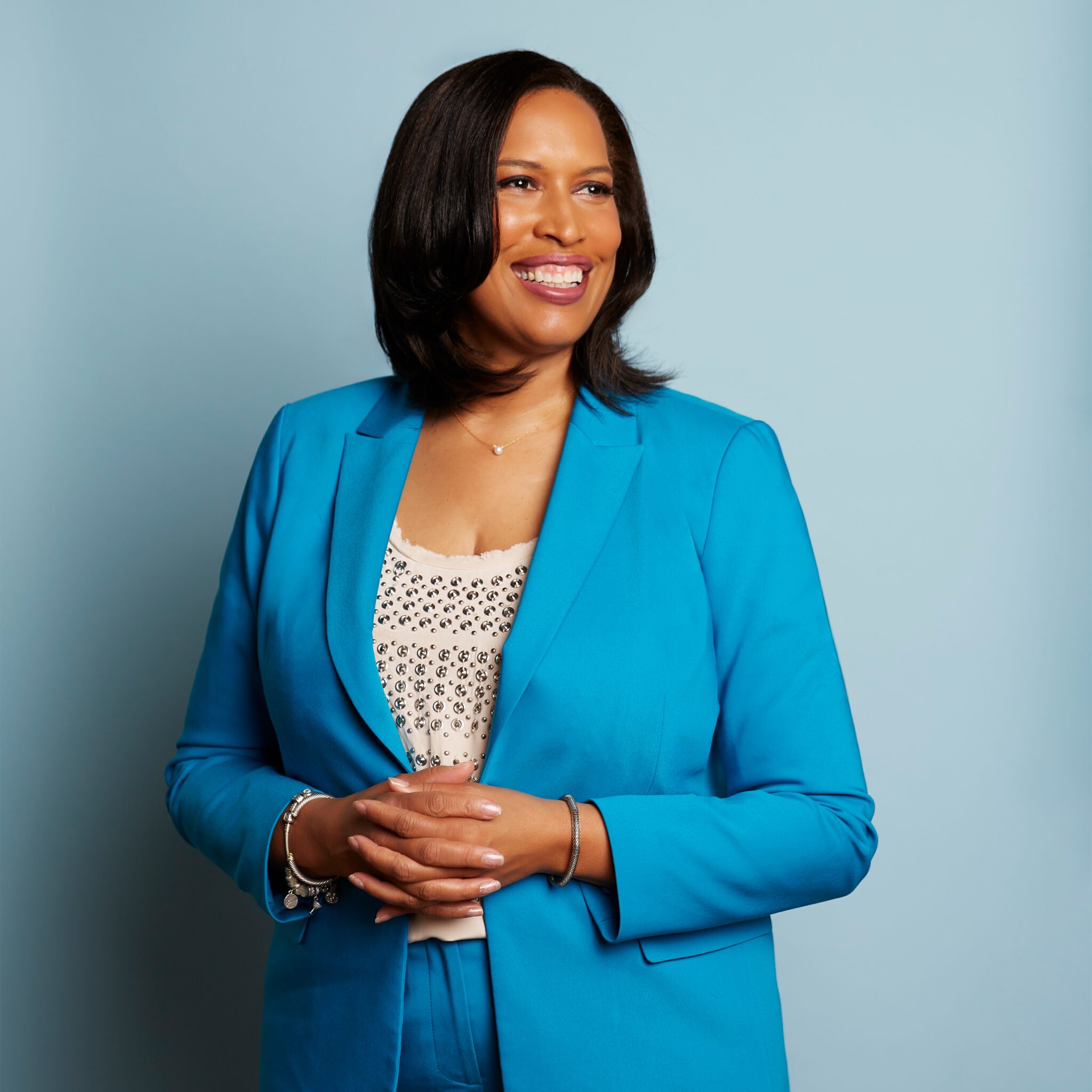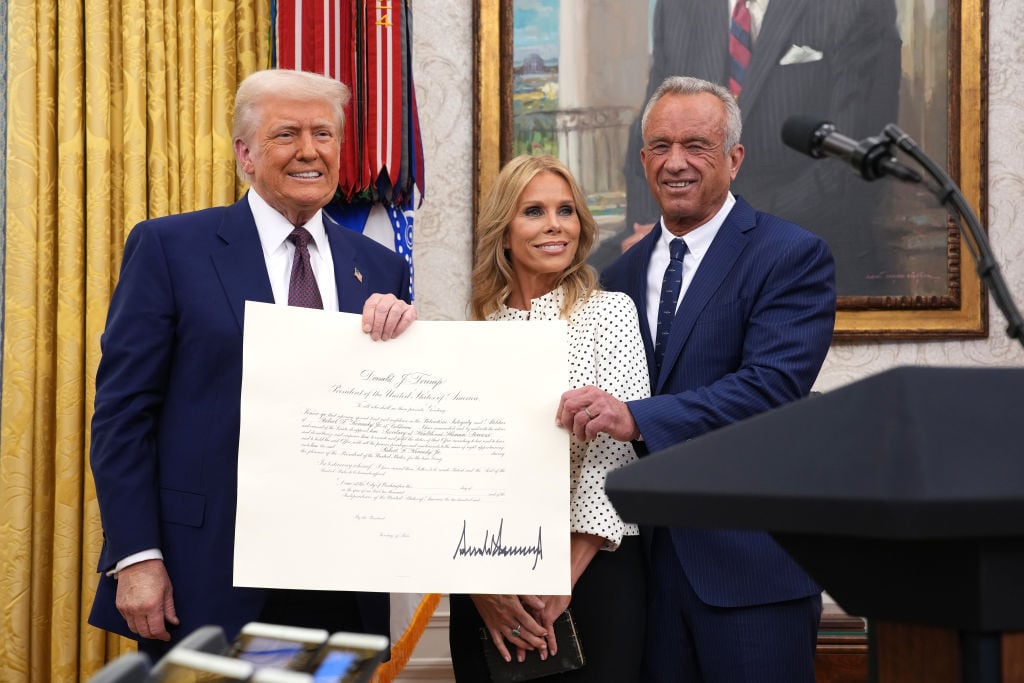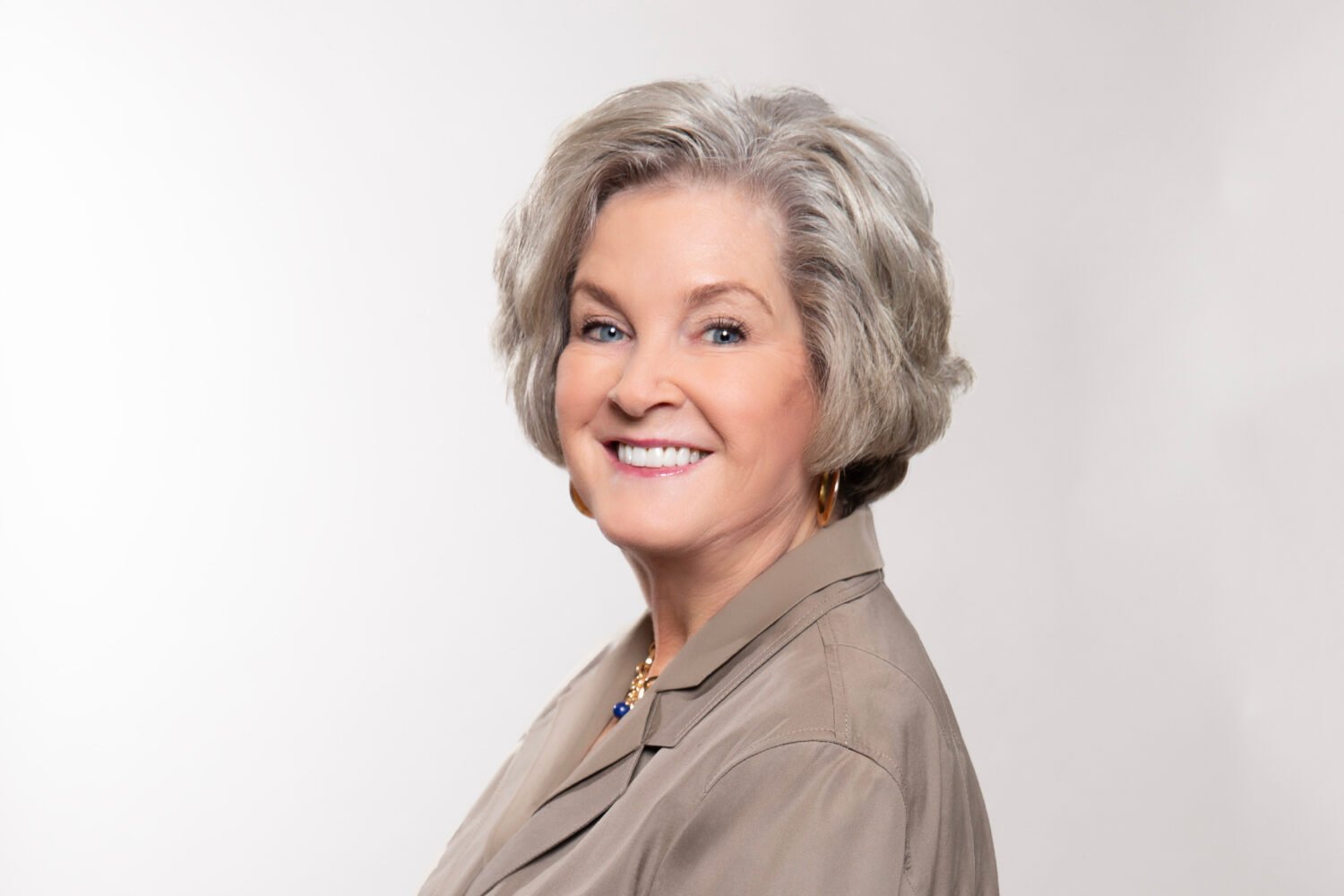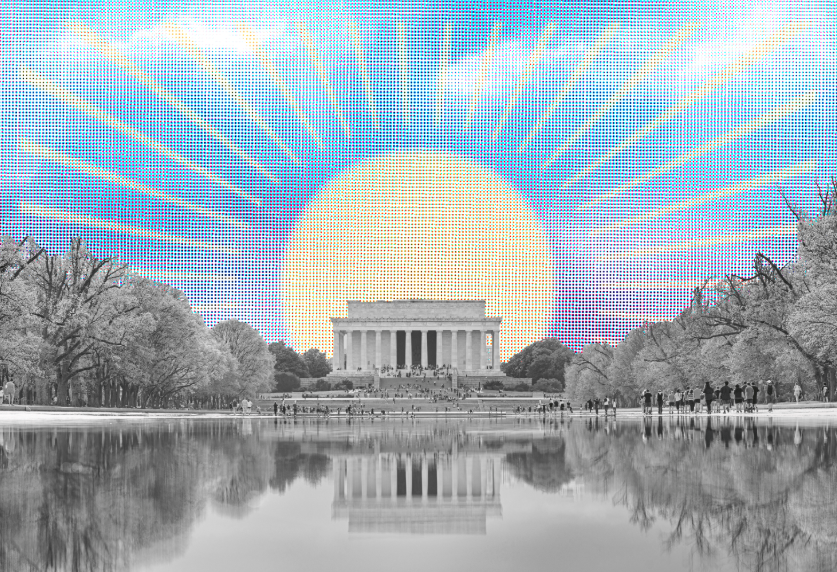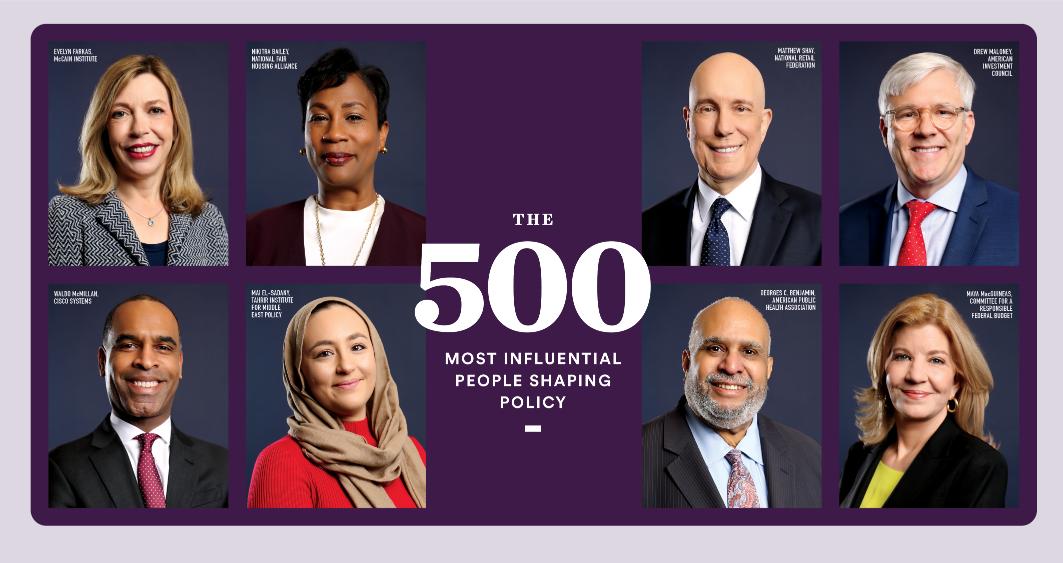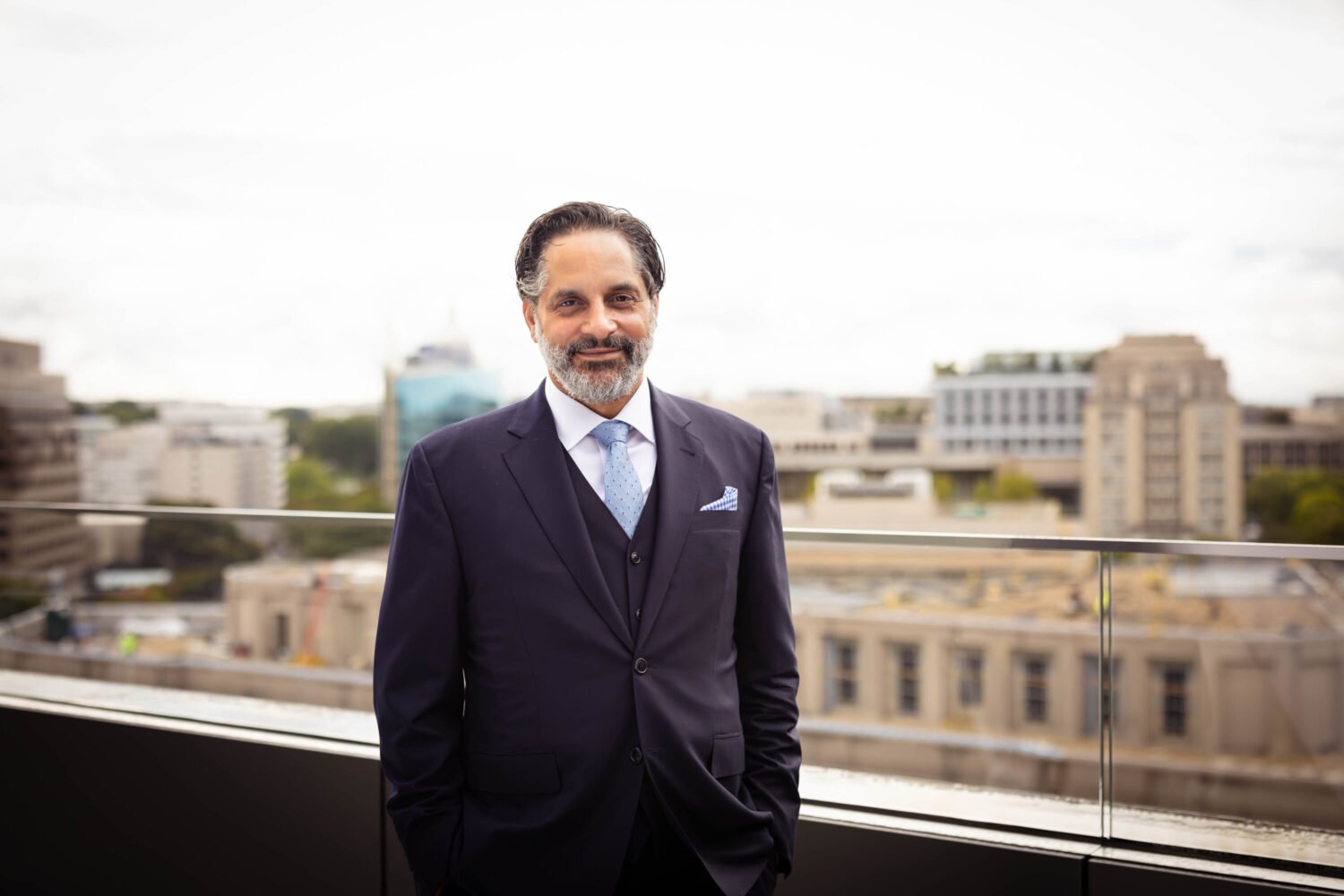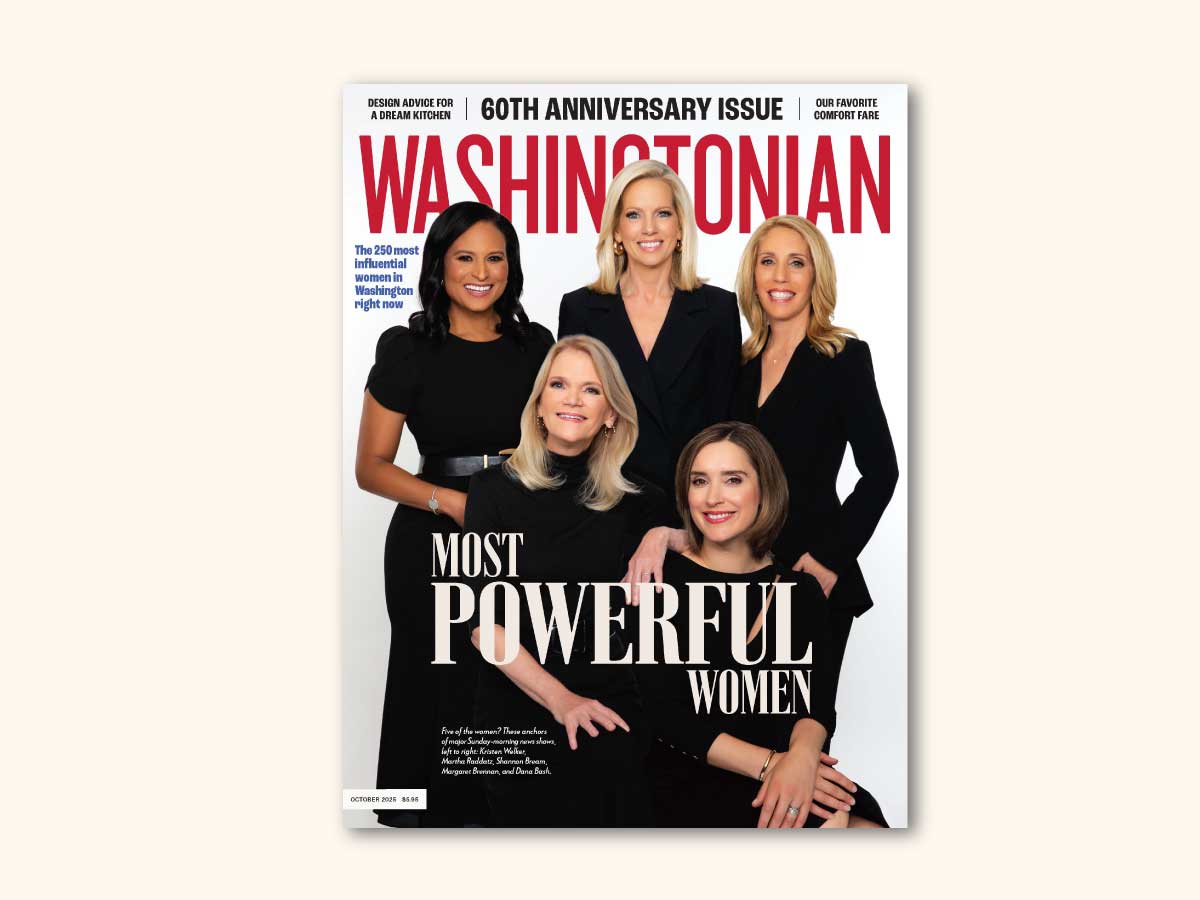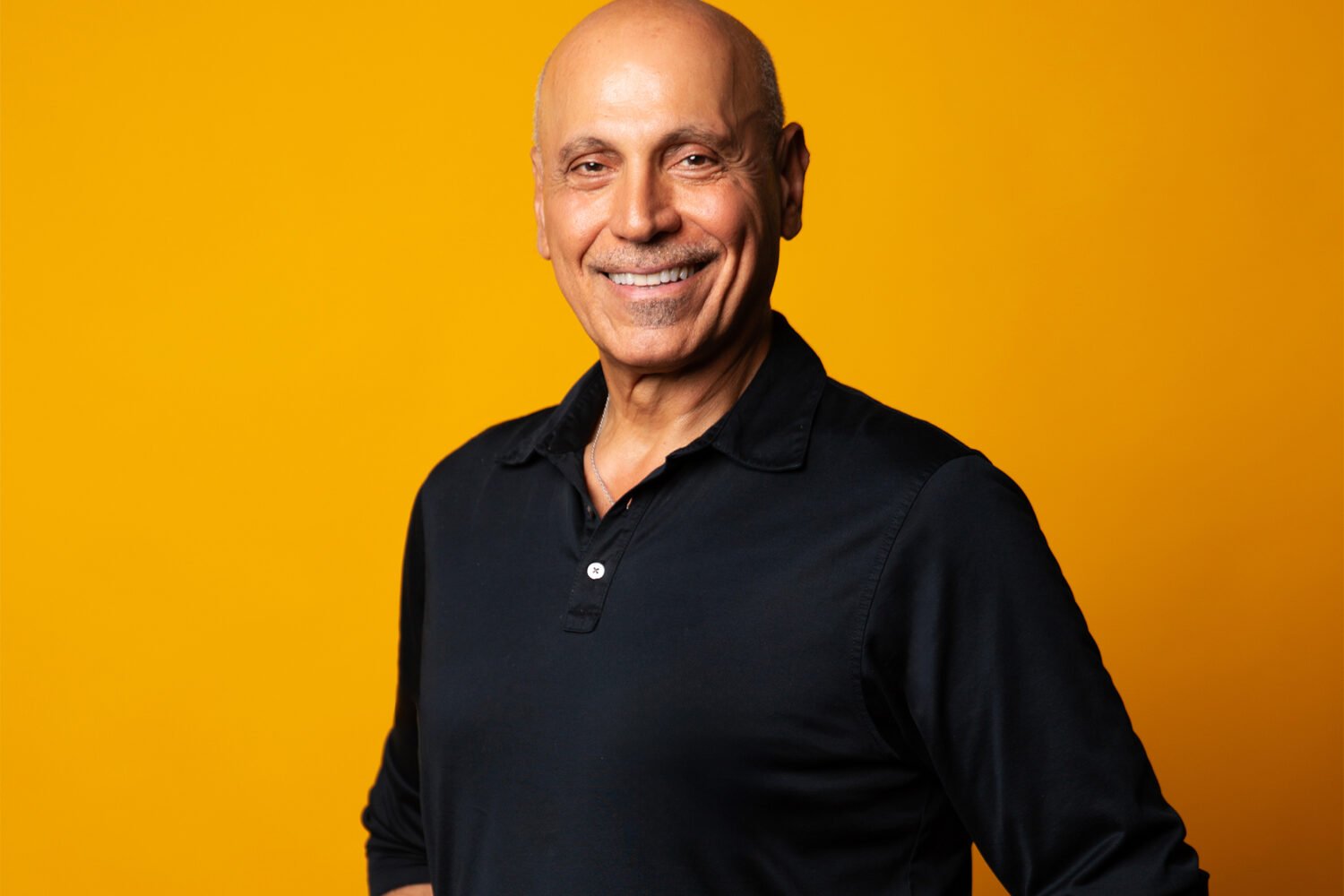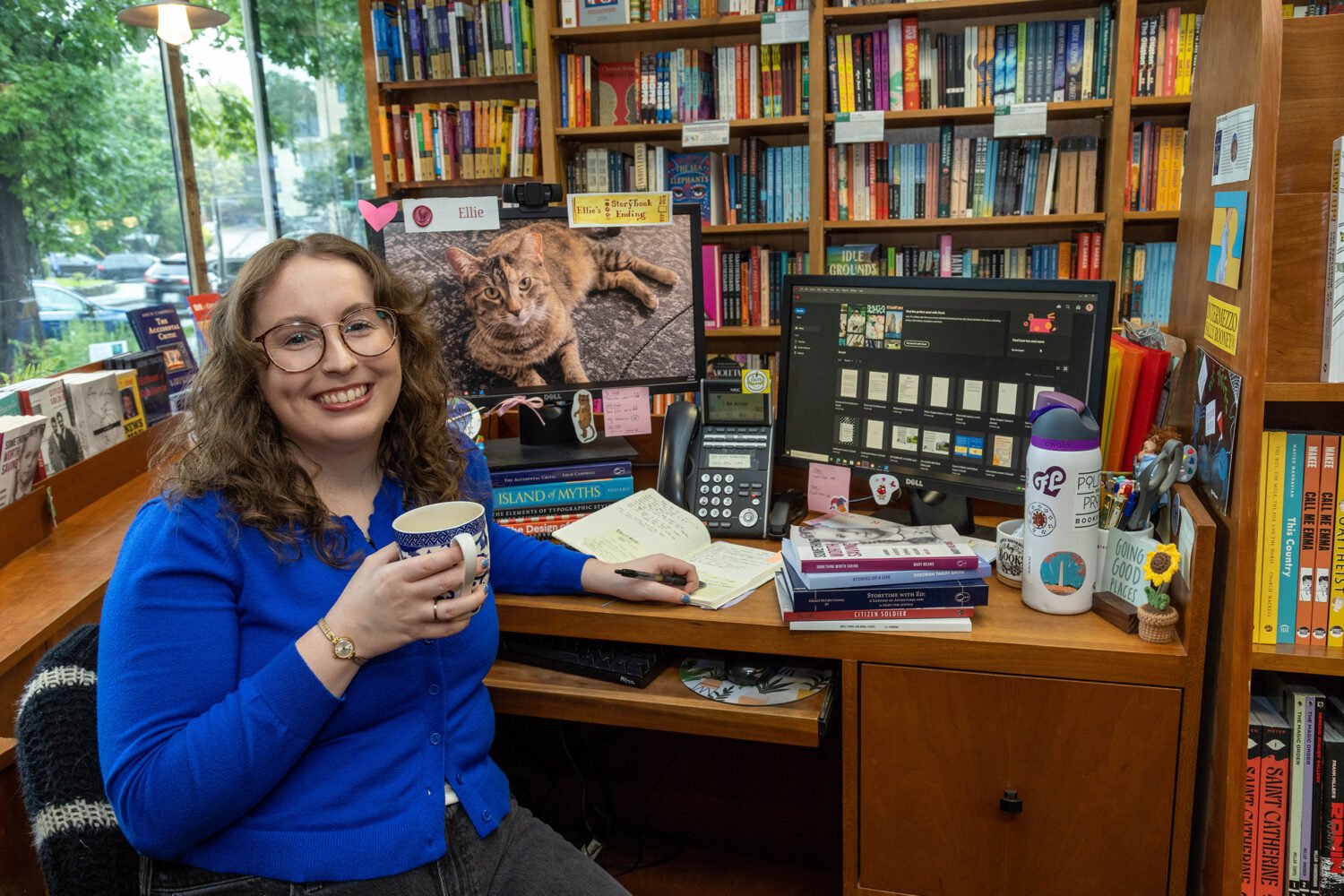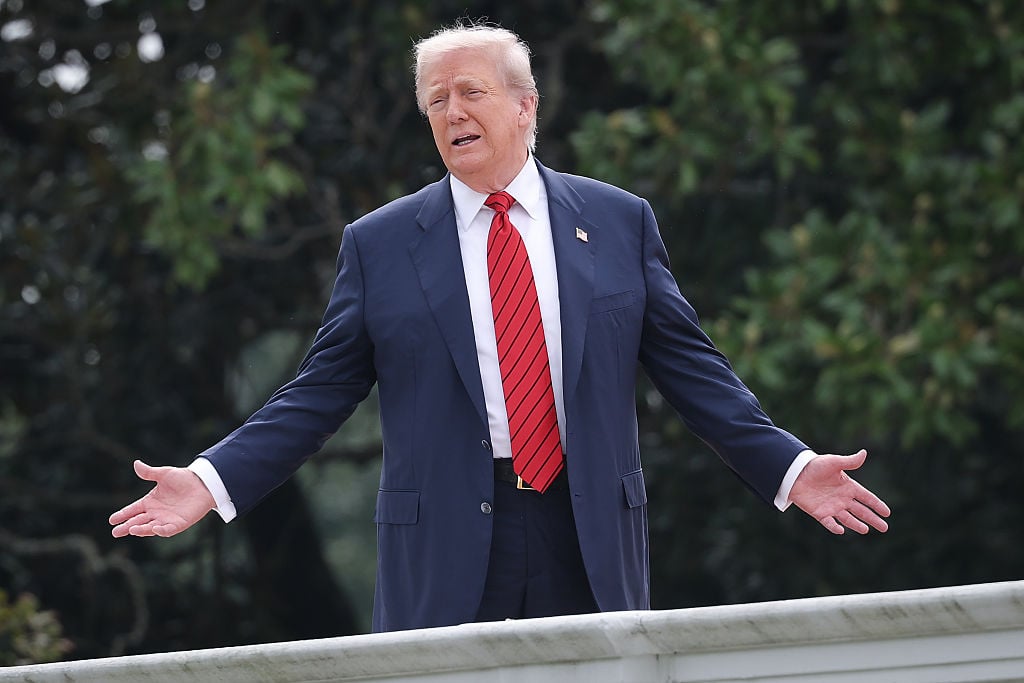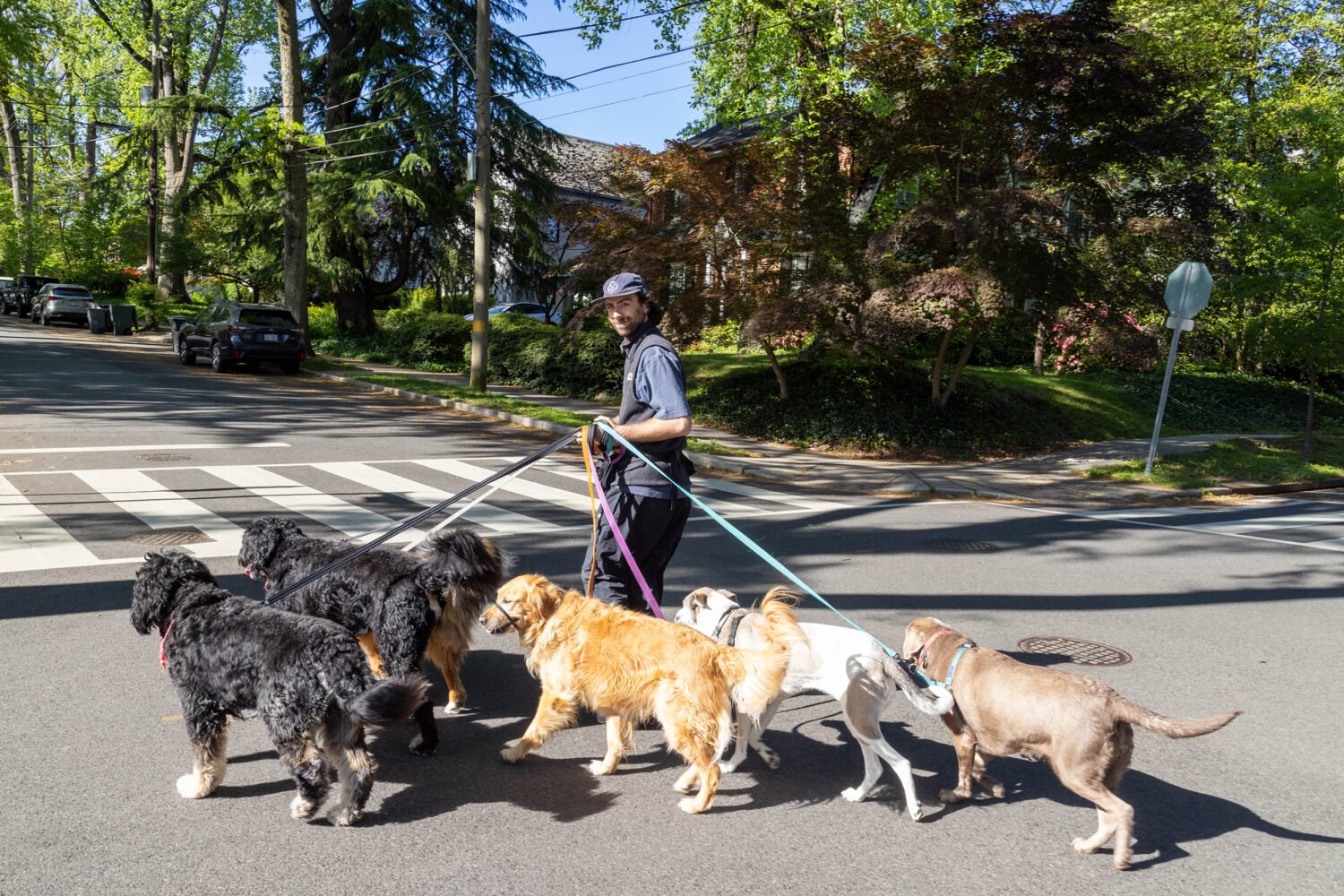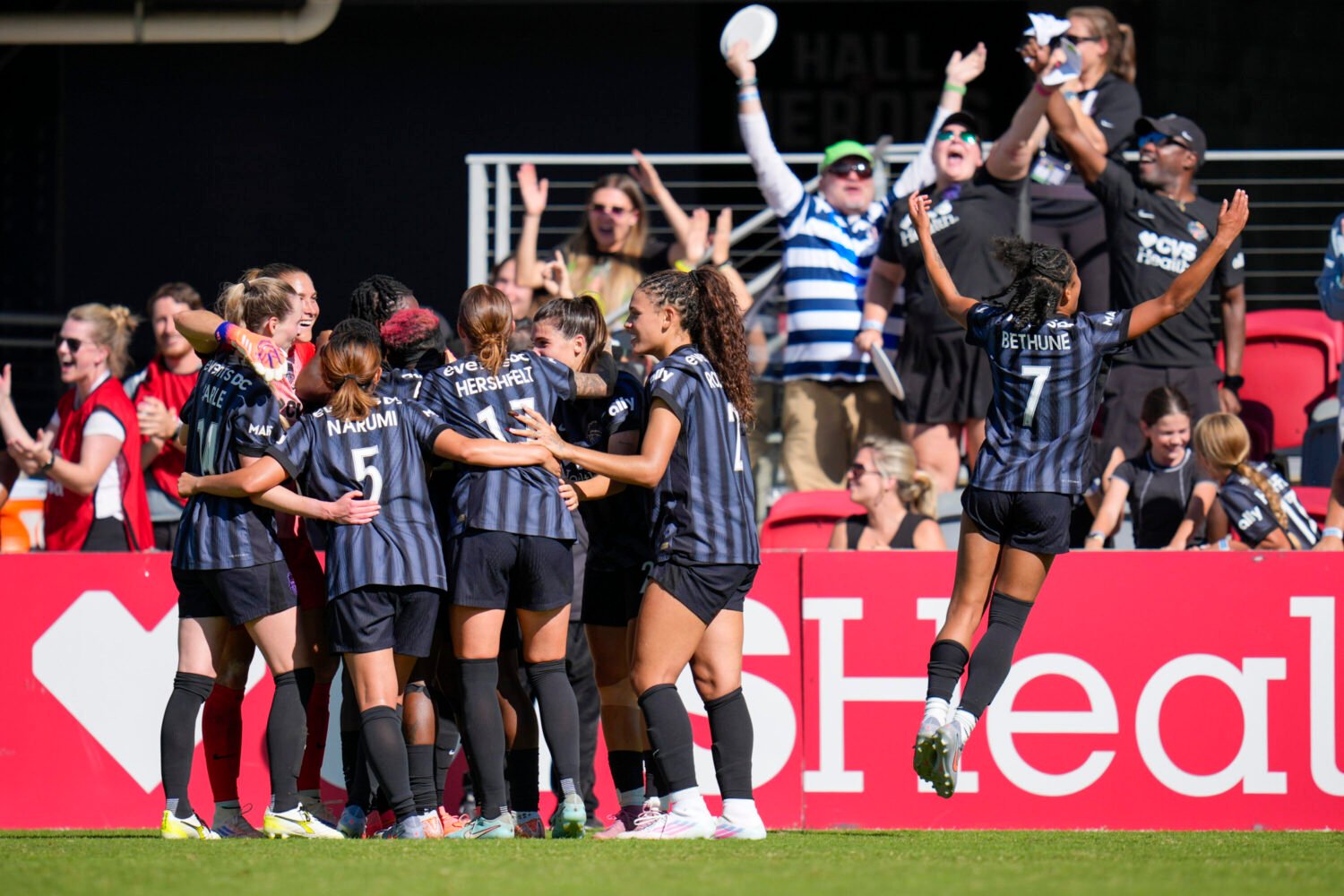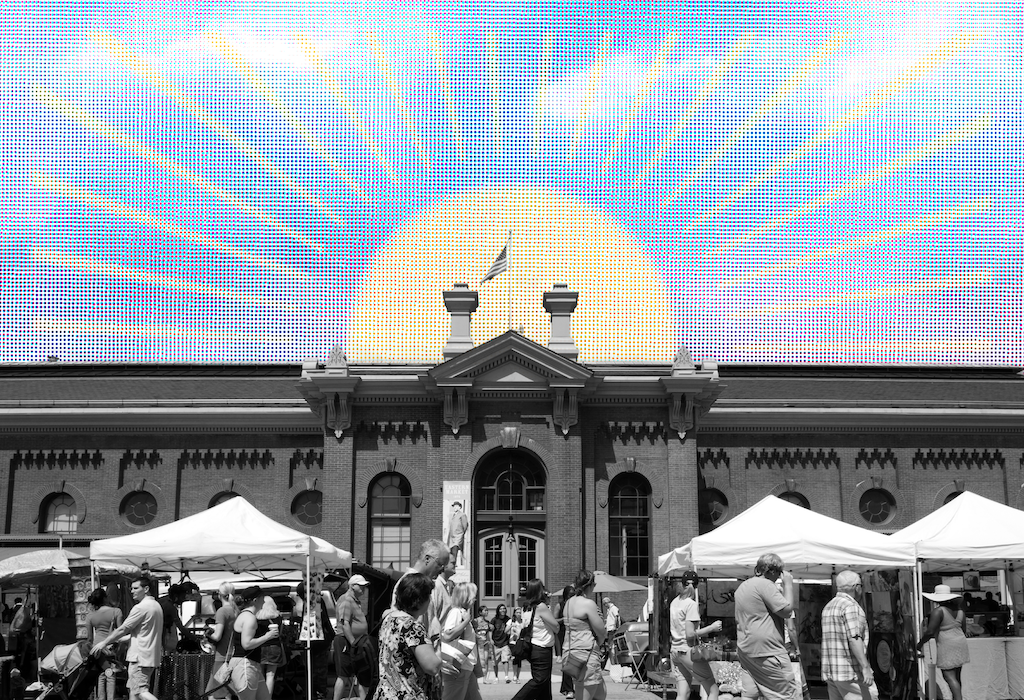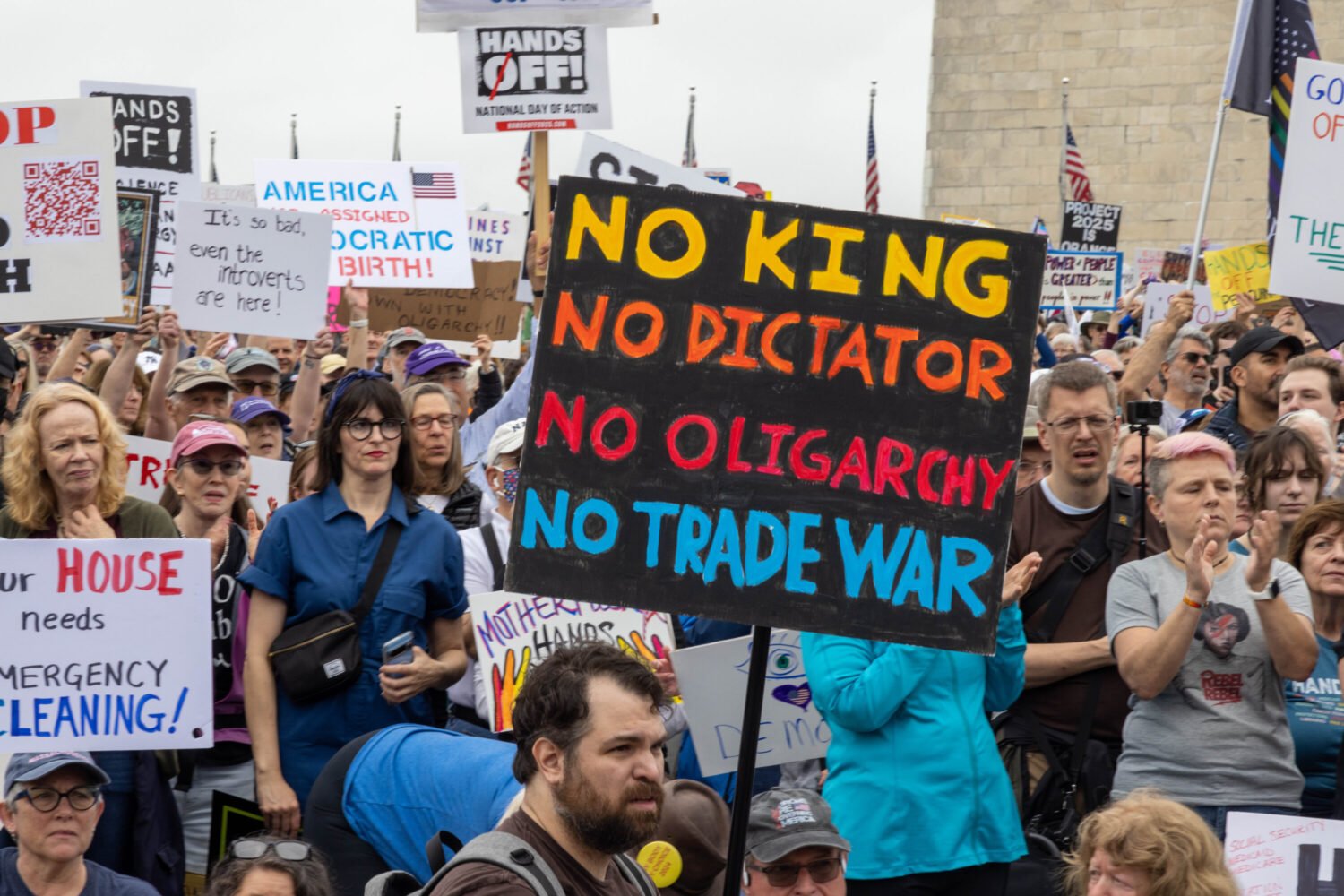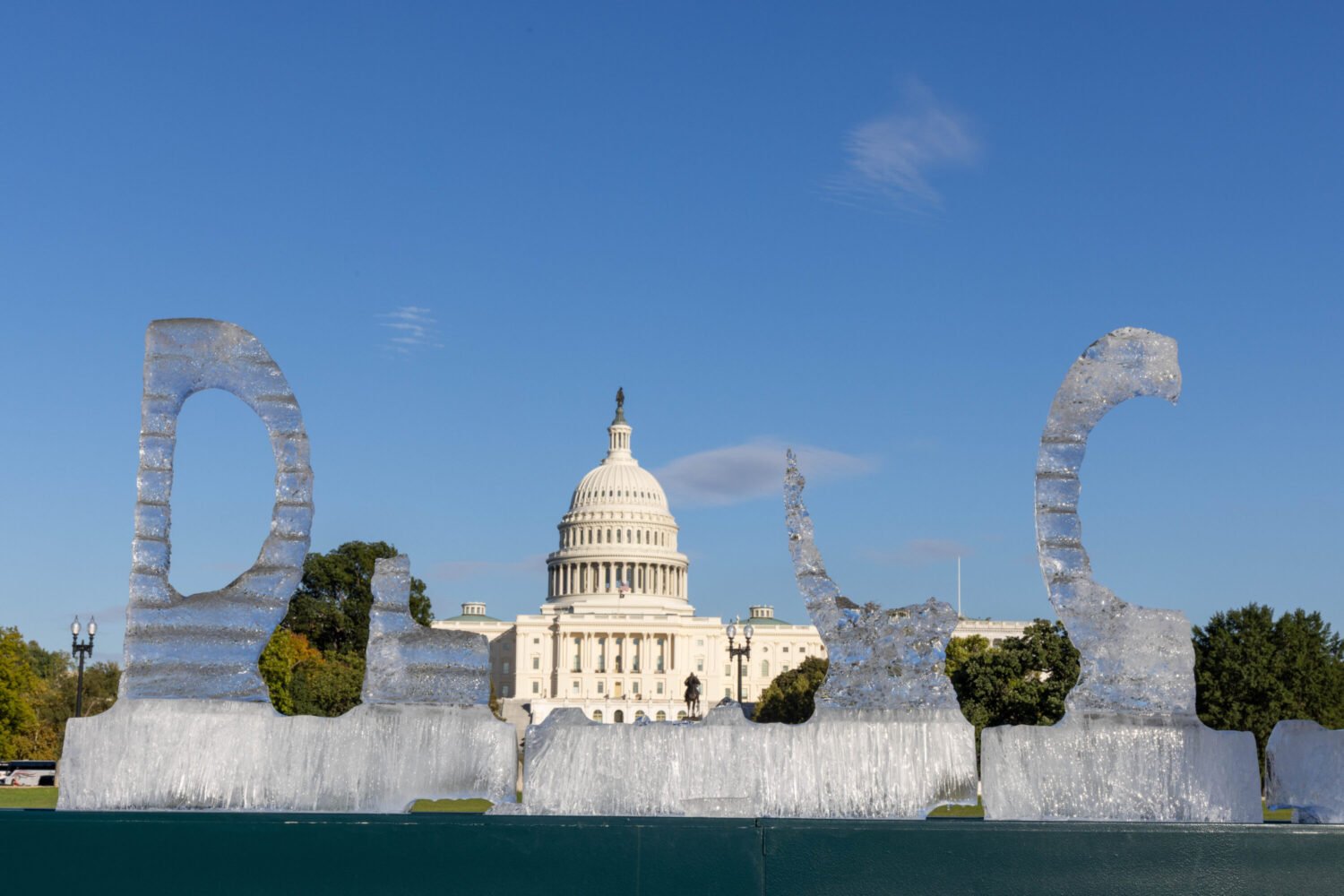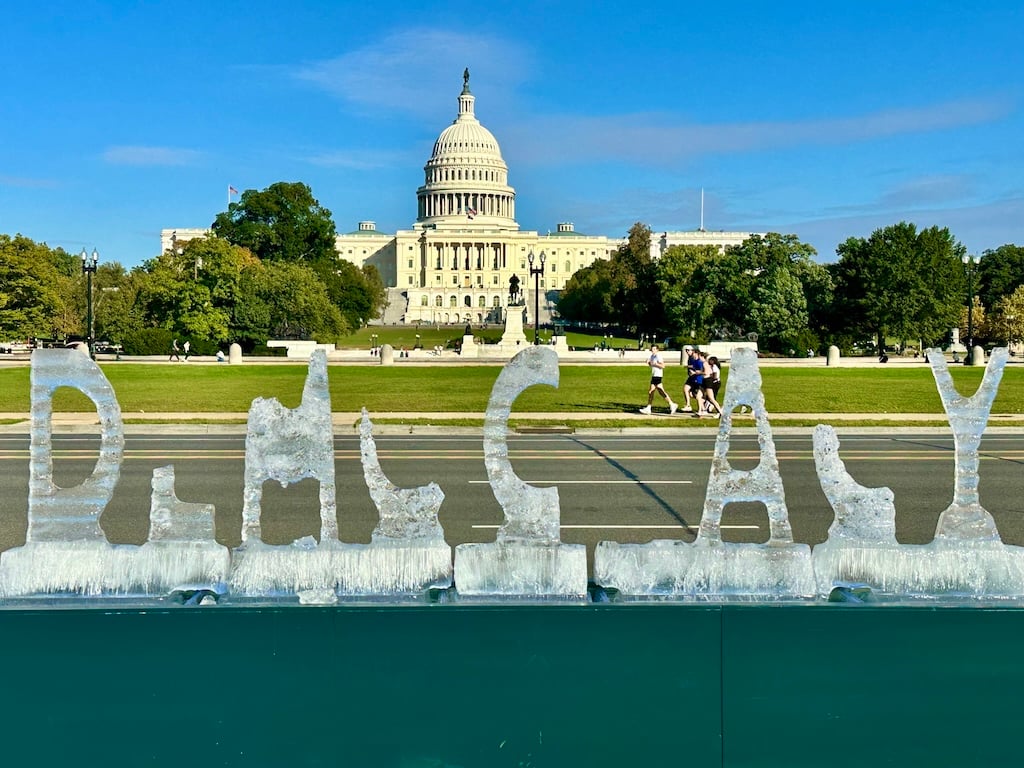Looking out the ninth-floor window of the hotel that Mayor Muriel Bowser’s team has picked for our interview, it’s easy to see why they may have suggested this spot: The room overlooks the Frederick Douglass Memorial Bridge. That $480 million structure is thus far the largest and most tangible of the mayor’s accomplishments—a real and also symbolic connection between Anacostia and the new neighborhoods that have sprung up around Nats Park and Audi Field.
Bowser seems to be thinking more about her legacy lately, though she denied that when I suggested as much at the start of the interview. And it’s true that, ten years into her tenure, she still has a jam-packed agenda. Most prominently, she’s looking to win DC Council approval to remake the former site of RFK Stadium. The plan seems to be winning fans, but it comes during a difficult time for the city, when Bowser has been forced into uncomfortable compromises to appease President Trump, reversals of liberal policies, and hard budget-cut choices as the city faces a recession-like “DOGE economy.”
Bowser doesn’t do a lot of extended interviews, and she didn’t particularly seem to enjoy this one. But she was eager to explain how she thinks about her job and what her plans are for the next two years—and, perhaps, a fourth term.
You come off like a very private person–you tend to let your accomplishments speak for themselves. Your office reached out to suggest this interview, and around the same time, you put out a ten-year progress report. Are you thinking more about your legacy?
No. We put out a 12-month report every year. I’ve done one every year for the last ten years. I think it’s important to let people know how you’re doing with your promises. And a theme of this one is “Promises made, promises kept.” There have been very few mayors who can look back on ten years and be able to report on progress. So we’re very proud of that.
It appears the city is set to lose as many as 40,000 federal jobs due to Trump’s cuts. Your 2026 budget offers some new strategies for how DC’s economy could adapt. At the same time, the budget proposal has cuts to our safety net, and it pairs those with tax incentives for businesses. What kind of economy are you envisioning for DC in the future?
Well, I think [the local economy] is diverse and it’s growing, and that’s what any mayor wants for a city. You don’t want to be mayor of a town that people are running away from, where the population is declining, where nobody wants to open a business, where property values are spiraling down, where crime is rampant and your schools aren’t good. That’s not the town you want. I know towns like that. I grew up in one: right here in Washington, DC.
We were hopeful that a Trump administration would bring people back to the office, but instead they fired them.
The way we’ve been able to turn that around is to make robust investments in schools and public safety, and we have had a thriving downtown. Covid turned that around, and we saw how quickly we had to pivot to get people back in our downtown, to focus more on events and activities, tourism and entertainment.
We were hopeful that a Trump administration would bring people back to the office, but instead they fired them. We, of course, want to work with the administration to pause some of the strategies that we find devastating. We’re hopeful that some of the employees will be reinstated. We’re hopeful that they will pause on some of these real-estate decisions [such as selling major federal buildings] that could be devastating for the city.
But it feels like your budget is more focused on incentivizing future growth through business than on doing more to directly help people who are struggling. Why not double down on helping them a little bit more?
How would we pay for it? We have to be able to pay for that. It would be very hard to say to double down on those strategies when we already can’t pay for the strategies that exist. So I think the better question is: How can we make programs and services more efficient? How can we focus on our core activities? And how can we say, “This may be nice to have, we like it, but it’s not one of those core activities or safety-net activities that leads to more people moving here, more people staying here, more businesses moving here, more tourists coming here, or creating more jobs here.”
DC is quite a progressive city, but progressives have been losing ground lately. What’s one thing you’d like to accomplish in the future that’s in line with a more solidly Democratic or progressive agenda for the city?
I don’t know what that means. Our agenda is what it is. I don’t put labels on it. You can put labels on it. What we have focused on for ten years is how to grow this city in an inclusive way. And when you look at my record of investing in affordable housing, for example—I think we’re over $1.5 billion, now, invested in affordable housing—that has allowed us to blunt our rent increases compared to other places and create 36,000 new units of housing. But more than that, we have kind of a playbook for it. Because we’ve invested consistently and partnered with the private sector, we know what works and what can work in this city.
We’ve done the same with our homeless-services program. We transformed that system. We closed a notorious homeless shelter, created units of short-term family housing all over the city. As a result, we’ve driven down family homelessness by 61 percent. That’s a playbook. That playbook can also work in the single homeless system. I don’t know what you call that—is that solidly Democratic and progressive?
The new stadium is a project that’s closely identified with you personally, as a longtime dream of yours. Why did you want it to be identified with your legacy?
Well, I’m the mayor, so I make economic-development deals. I’m the only person in the District whose job that is, aside from the deputy mayor for economic development. So all of the economic-development projects during our tenure are going to be associated with me. This one has taken the longest, has been the hardest, has involved more twists and turns and levels of government. So I think that’s why it gets a lot of attention. People want our home team back.
Another subject that the ten-year progress report brings up is streamlining development, which is also mentioned in the new budget. Do you think of yourself as a YIMBY?
I don’t know if I would use that term, but I believe in building affordable housing everywhere.
Do you think that getting infrastructure projects built and cutting through red tape should be a big policy goal for more Democrats in the country?
I mean, it is for us. The Frederick Douglass Memorial Bridge has become iconic of Washington, DC. [The new football stadium] will become the biggest infrastructure project. We have to put people to work. And when you talk about the Democrats—I’m a mayor, and so just by definition, mayors have a job to do. You’ve heard the phrase “There’s no Democrat or Republican way to pick up the trash.” We’re more practical in our approach to delivering services and being accountable to the people that we serve. [DC] is a small place. We’re very compact. So we have to make the most of all the available land that we have.
Bowser with team owner Josh Harris and NFL commissioner Roger Goodell at the stadium-deal announcement. Photograph by Khalid Naji-Allah.
Your term as mayor is up at the end of 2026. When do you plan to announce if you’ll run for a fourth term?
You know, I’m not sure. We’re getting through our budget process. We have our RFK deal to be approved by the council, and then I would think we are in a place where we can talk about elections.
I did want to ask you about Black Lives Matter Plaza, which you recently decided to dismantle after Republicans in Congress started making an issue of it. I was just talking to someone who described it as one of the great public artworks of our time, and a large majority of Washingtonians disapproved of its removal, including 75 percent of Black Washingtonians. Do you think removing it was a mistake?
No.
Why is that?
I agree that it was one of the greatest pieces of public art, but I probably think of it in that way for different reasons than most because I know why I put it [there]. I used public art to save our city from what I thought could be a very dangerous night [Friday, June 5, just after protesters clashed with federal law-enforcement troops near the White House]. And I did it to protect protesters and to protect our neighborhoods. Now, I certainly didn’t put it [there] because I thought people around the world would replicate it. I didn’t really put it [there] to poke at Donald Trump. It was to give people a safe place to be, and our police a safe place to support peaceful protests. So I think that purpose was served. And having a mural stop us from being able to govern our city is not justifiable.
So you felt that it served its purpose, and once Republicans were threatening to revoke transportation funds over the plaza, it wasn’t worth keeping?
I’m not talking about transportation funds—I’m talking about our autonomy.
Home rule.
Yes. Every conversation with the President, with the Congress, they can’t all start with Black Lives Matter Plaza when they should be focused on Medicaid or focused on budget matters or focused on how the federal government can get people back to work and inject life into our economy. Those are the conversations we have to have.
Looking out the ninth-floor window of the hotel that Mayor Muriel Bowser’s team has picked for our interview, it’s easy to see why they may have suggested this spot: The room overlooks the Frederick Douglass Memorial Bridge. That $480 million structure is thus far the largest and most tangible of the mayor’s accomplishments—a real and also symbolic connection between Anacostia and the new neighborhoods that have sprung up around Nats Park and Audi Field.
Bowser seems to be thinking more about her legacy lately, though she denied that when I suggested as much at the start of the interview. And it’s true that, ten years into her tenure, she still has a jam-packed agenda. Most prominently, she’s looking to win DC Council approval to remake the former site of RFK Stadium. The plan seems to be winning fans, but it comes during a difficult time for the city, when Bowser has been forced into uncomfortable compromises to appease President Trump, reversals of liberal policies, and hard budget-cut choices as the city faces a recession-like “DOGE economy.”
Bowser doesn’t do a lot of extended interviews, and she didn’t particularly seem to enjoy this one. But she was eager to explain how she thinks about her job and what her plans are for the next two years—and, perhaps, a fourth term.
You come off like a very private person–you tend to let your accomplishments speak for themselves. Your office reached out to suggest this interview, and around the same time, you put out a ten-year progress report. Are you thinking more about your legacy?
No. We put out a 12-month report every year. I’ve done one every year for the last ten years. I think it’s important to let people know how you’re doing with your promises. And a theme of this one is “Promises made, promises kept.” There have been very few mayors who can look back on ten years and be able to report on progress. So we’re very proud of that.
It appears the city is set to lose as many as 40,000 federal jobs due to Trump’s cuts. Your 2026 budget offers some new strategies for how DC’s economy could adapt. At the same time, the budget proposal has cuts to our safety net, and it pairs those with tax incentives for businesses. What kind of economy are you envisioning for DC in the future?
Well, I think [the local economy] is diverse and it’s growing, and that’s what any mayor wants for a city. You don’t want to be mayor of a town that people are running away from, where the population is declining, where nobody wants to open a business, where property values are spiraling down, where crime is rampant and your schools aren’t good. That’s not the town you want. I know towns like that. I grew up in one: right here in Washington, DC.
We were hopeful that a Trump administration would bring people back to the office, but instead they fired them.
The way we’ve been able to turn that around is to make robust investments in schools and public safety, and we have had a thriving downtown. Covid turned that around, and we saw how quickly we had to pivot to get people back in our downtown, to focus more on events and activities, tourism and entertainment.
We were hopeful that a Trump administration would bring people back to the office, but instead they fired them. We, of course, want to work with the administration to pause some of the strategies that we find devastating. We’re hopeful that some of the employees will be reinstated. We’re hopeful that they will pause on some of these real-estate decisions [such as selling major federal buildings] that could be devastating for the city.
But it feels like your budget is more focused on incentivizing future growth through business than on doing more to directly help people who are struggling. Why not double down on helping them a little bit more?
How would we pay for it? We have to be able to pay for that. It would be very hard to say to double down on those strategies when we already can’t pay for the strategies that exist. So I think the better question is: How can we make programs and services more efficient? How can we focus on our core activities? And how can we say, “This may be nice to have, we like it, but it’s not one of those core activities or safety-net activities that leads to more people moving here, more people staying here, more businesses moving here, more tourists coming here, or creating more jobs here.”
DC is quite a progressive city, but progressives have been losing ground lately. What’s one thing you’d like to accomplish in the future that’s in line with a more solidly Democratic or progressive agenda for the city?
I don’t know what that means. Our agenda is what it is. I don’t put labels on it. You can put labels on it. What we have focused on for ten years is how to grow this city in an inclusive way. And when you look at my record of investing in affordable housing, for example—I think we’re over $1.5 billion, now, invested in affordable housing—that has allowed us to blunt our rent increases compared to other places and create 36,000 new units of housing. But more than that, we have kind of a playbook for it. Because we’ve invested consistently and partnered with the private sector, we know what works and what can work in this city.
We’ve done the same with our homeless-services program. We transformed that system. We closed a notorious homeless shelter, created units of short-term family housing all over the city. As a result, we’ve driven down family homelessness by 61 percent. That’s a playbook. That playbook can also work in the single homeless system. I don’t know what you call that—is that solidly Democratic and progressive?
The new stadium is a project that’s closely identified with you personally, as a longtime dream of yours. Why did you want it to be identified with your legacy?
Well, I’m the mayor, so I make economic-development deals. I’m the only person in the District whose job that is, aside from the deputy mayor for economic development. So all of the economic-development projects during our tenure are going to be associated with me. This one has taken the longest, has been the hardest, has involved more twists and turns and levels of government. So I think that’s why it gets a lot of attention. People want our home team back.
Another subject that the ten-year progress report brings up is streamlining development, which is also mentioned in the new budget. Do you think of yourself as a YIMBY?
I don’t know if I would use that term, but I believe in building affordable housing everywhere.
Do you think that getting infrastructure projects built and cutting through red tape should be a big policy goal for more Democrats in the country?
I mean, it is for us. The Frederick Douglass Memorial Bridge has become iconic of Washington, DC. [The new football stadium] will become the biggest infrastructure project. We have to put people to work. And when you talk about the Democrats—I’m a mayor, and so just by definition, mayors have a job to do. You’ve heard the phrase “There’s no Democrat or Republican way to pick up the trash.” We’re more practical in our approach to delivering services and being accountable to the people that we serve. [DC] is a small place. We’re very compact. So we have to make the most of all the available land that we have.

Your term as mayor is up at the end of 2026. When do you plan to announce if you’ll run for a fourth term?
You know, I’m not sure. We’re getting through our budget process. We have our RFK deal to be approved by the council, and then I would think we are in a place where we can talk about elections.
I did want to ask you about Black Lives Matter Plaza, which you recently decided to dismantle after Republicans in Congress started making an issue of it. I was just talking to someone who described it as one of the great public artworks of our time, and a large majority of Washingtonians disapproved of its removal, including 75 percent of Black Washingtonians. Do you think removing it was a mistake?
No.
Why is that?
I agree that it was one of the greatest pieces of public art, but I probably think of it in that way for different reasons than most because I know why I put it [there]. I used public art to save our city from what I thought could be a very dangerous night [Friday, June 5, just after protesters clashed with federal law-enforcement troops near the White House]. And I did it to protect protesters and to protect our neighborhoods. Now, I certainly didn’t put it [there] because I thought people around the world would replicate it. I didn’t really put it [there] to poke at Donald Trump. It was to give people a safe place to be, and our police a safe place to support peaceful protests. So I think that purpose was served. And having a mural stop us from being able to govern our city is not justifiable.
So you felt that it served its purpose, and once Republicans were threatening to revoke transportation funds over the plaza, it wasn’t worth keeping?
I’m not talking about transportation funds—I’m talking about our autonomy.
Home rule.
Yes. Every conversation with the President, with the Congress, they can’t all start with Black Lives Matter Plaza when they should be focused on Medicaid or focused on budget matters or focused on how the federal government can get people back to work and inject life into our economy. Those are the conversations we have to have.
This article appears in the July 2025 issue of Washingtonian.

